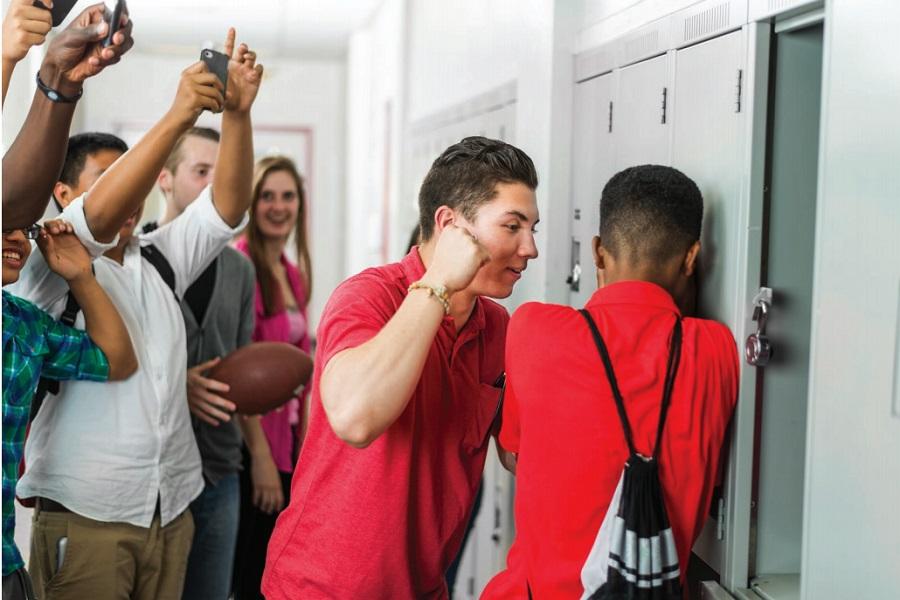It is sometimes hard as a bystander to intervene in or stand up to bullying behaviour because we fear we may become the target of the behaviour. This lesson will explore some practical strategies for standing up against bullying behaviour in a safe and respectful way.

Year level
7-10

Duration
60 minutes

Type
In class activity
Take away activity

SEL Competencies
Social awareness
Responsible decision-making
Learning intention
Students will be able to develop and practise using strategies for standing up to bullying behaviour.
Key outcomes
By the end of the lesson, students will be able to:
understand the role bystanders play in stopping bullying behaviour
implement practical strategies for calling out bullying.
Materials needed
An image of bullying incident.
Mapped to
Australian Curriculum: Health and Physical Education
Refine protective behaviours and evaluate community resources to seek help for themselves and others (AC9HP8P08)
Plan and implement strategies, using health resources, to enhance their own and others’ health, safety, relationships and wellbeing (AC9HP8P10)
Analyse factors that shape identities and evaluate how individuals influence the identities of others (AC9HP10P01)
Plan, rehearse and evaluate strategies for managing situations where their own or others’ health, safety or wellbeing may be at risk (AC9HP10P08)
Plan, justify and critique strategies to enhance their own and others’ health, safety, relationships and wellbeing (AC9HP10P10)
Australian Curriculum: General Capabilities
Personal and Social Capability:
Social awareness
Social management
Ethical Understanding:
Responding to ethical issues
Understanding ethical concepts and perspectives
Critical and Creative Thinking:
Generating
Reflecting
Analysing
NSW PDHPE Syllabus
Investigates health practices, behaviours and resources to promote health, safety, wellbeing and physically active communities (PD4-7)
Demonstrates how movement skills and concepts can be adapted and transferred to enhance and perform movement sequences (PD4-11)
Plans, implements and critiques strategies to promote health, safety, wellbeing and participation in physical activity in their communities (PD5-7)
Refines and applies movement skills and concepts to compose and perform innovative movement sequences (PD5-11)
Victorian Curriculum: Health and Physical Education
Investigate the benefits of relationships and examine their impact on their own and others’ health and wellbeing (VCHPEP127)
Evaluate situations and propose appropriate emotional responses and then reflect on possible outcomes of different responses to health and wellbeing (VCHPEP147)
Activity 1
Classroom discussion: Bystanders
5 minutes
Discuss with students the prevalence of bystanders witnessing bullying behaviour in school:
Ask students to stand up if they have witnessed bullying behaviour in or around school or online.
Ask students to remain standing if they wished they had responded differently as a bystander.
Activity 2
Investigation and application
10 minutes
Display the image below or an image suitable to your students. Tell the students that research has shown that student bystanders are usually present when bullying occurs, and that in about half the cases the bullying stops if a bystander speaks up to discourage it.
As a class group, discuss the following questions:
Do you think this is a realistic example of the type of bullying that happens in school?
How might the person exhibiting the bullying behaviour feel in this scenario?
How might the person experiencing the bullying feel?
How might the bystanders have contributed to the way each of them felt?
What options did the bystanders have in responding to the bullying?
How could each of their options for responding have added to or reduced the extent of the bullying?
Activity 3
In-class activity
45 minutes
Divide students into pairs.
Students write a script or draw a comic of how one or more of the bystanders could stand up to bullying behaviour.
Collect each pair’s script and then hand them out to different pairs so that the students don’t know who the original authors were. Ask the new pair to read out the scripted response, and the class to indicate with a thumbs up if they think the response would have a positive outcome, thumb sideways if it would have no impact, and thumbs down if it would have a negative outcome.
For the thumbs-down responses, ask students to identify why they think the response would lead to a negative outcome. Brainstorm how the response could be changed to have a more positive outcome.
For the thumbs-up responses, ask students to identify which responses they would feel comfortable using if they were a bystander in a similar situation. If time permits, get students to role-play the responses.
Activity 4
Take-away activity
15 minutes
Students create a list of strategies or scripts that ‘digital bystanders’ can use to stand up to people exhibiting cyberbullying and to be allies for their peers online.





